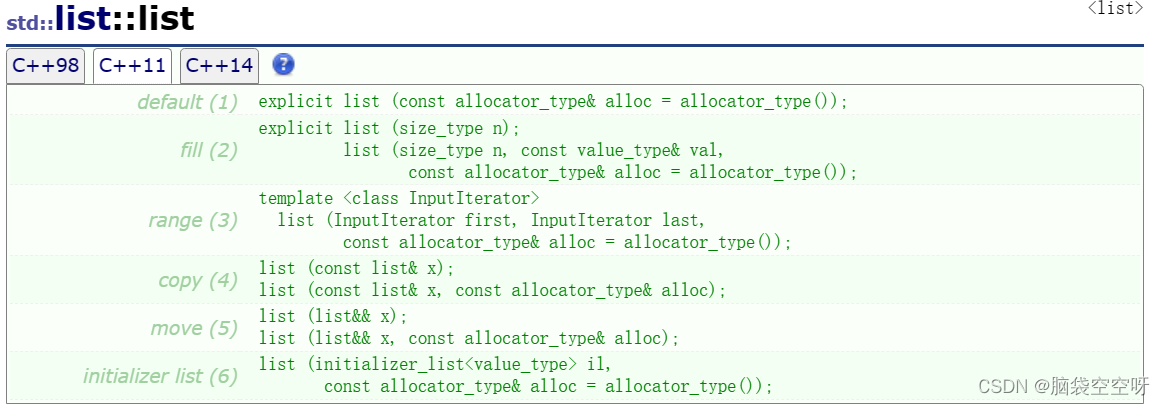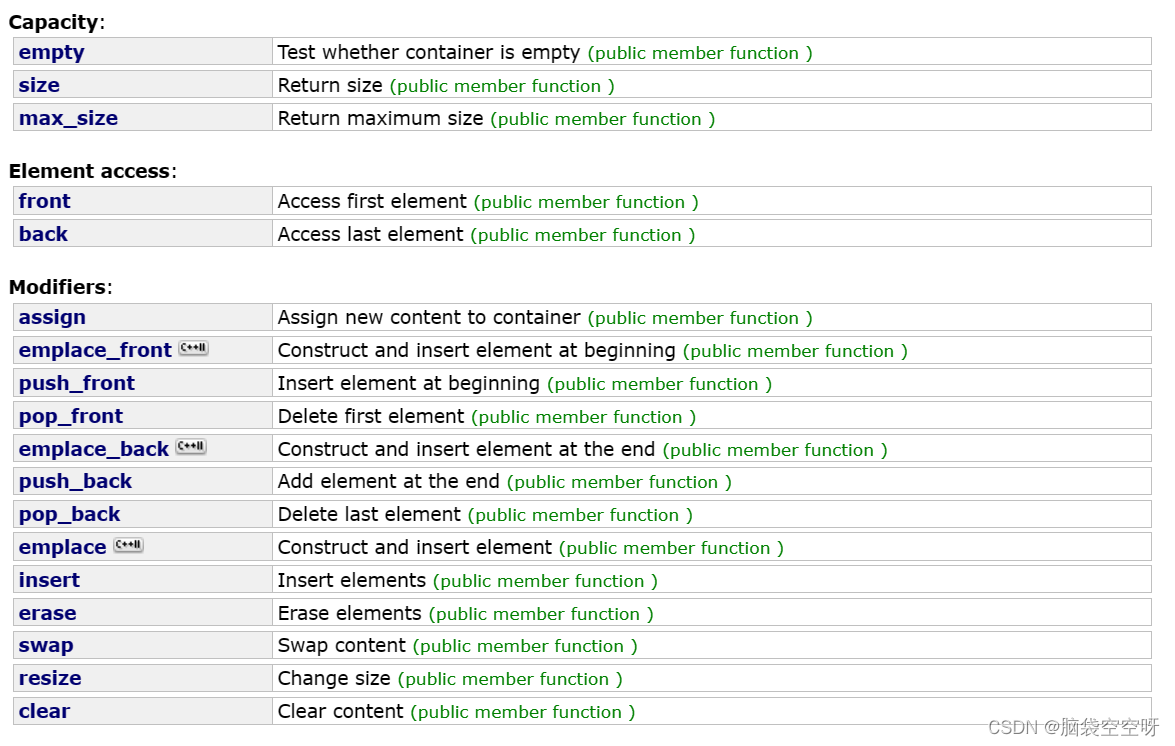在C++标准库中,list 是一个双向链表容器,用于存储一系列元素。与 vector 和 deque 等容器不同,list 使用带头双向循环链表的数据结构来组织元素,因此list插入删除的效率非常高。
list的使用

list的构造函数

list迭代器

list的成员函数

list的模拟实现
template<class T>
struct list_node {
list_node<T>* _next;
list_node<T>* _prev;
T _data;
list_node(const T& x=T())
:_next(nullptr)
, _prev(nullptr)
, _data(x)
{}
};
template<class T,class Ref,class Ptr>
struct _list_iterator {
typedef list_node<T> node;
typedef _list_iterator<T,Ref,Ptr> self;
node* _node;
_list_iterator(node* n)
:_node(n)
{}
Ref operator*() {
return _node->_data;
}
Ptr operator->() {
return &_node->_data;
}
self& operator++() {
_node = _node->_next;
return *this;
}
self& operator--() {
_node = _node->_prev;
return *this;
}
self operator++(int) {
self tmp(*this);
_node = _node->_next;
return tmp;
}
self operator--(int) {
self tmp(*this);
_node = _node->_prev;
return tmp;
}
bool operator==(const self& s) {
return _node == s._node;
}
bool operator!=(const self& s) {
return _node != s._node;
}
};
/*template<class T>
struct _list_const_iterator {
typedef list_node<T> node;
typedef _list_const_iterator<T> self;
node* _node;
_list_const_iterator(node* n)
:_node(n)
{}
const T& operator*() {
return _node->_data;
}
self& operator++() {
_node = _node->_next;
return *this;
}
self& operator--() {
_node = _node->_prev;
return *this;
}
self operator++(int) {
self tmp(*this);
_node = _node->_next;
return tmp;
}
self operator--(int) {
self tmp(*this);
_node = _node->_prev;
return tmp;
}
bool operator==(const self& s) {
return _node == s._node;
}
bool operator!=(const self& s) {
return _node != s._node;
}
};*/
template<class T>
class list {
typedef list_node<T> node;
public:
typedef _list_iterator<T,T&,T*> iterator;
typedef _list_iterator<T,const T&,const T*> const_iterator;
//typedef _list_const_iterator<T> const_iterator;
typedef ReverseIterator<iterator, T&, T*> reverse_iterator;
typedef ReverseIterator<const_iterator, const T&, const T*> const_reverse_iterator;
/*reverse_iterator rbegin()
{
return reverse_iterator(_head->_prev);
}
reverse_iterator rend()
{
return reverse_iterator(_head);
}*/
reverse_iterator rbegin()
{
return reverse_iterator(end());
}
reverse_iterator rend()
{
return reverse_iterator(begin());
}
iterator begin() {
//iterator it(_head->next);
//return it;
return iterator(_head->_next);
}
const_iterator begin() const{
return const_iterator(_head->_next);
}
iterator end() {
//iterator it(_head);
//return it;
return iterator(_head);
}
const_iterator end() const{
return const_iterator(_head);
}
void empty_init() {
_head = new node;
_head->_next = _head;
_head->_prev = _head;
}
list() {
empty_init();
}
template <class Iterator>
list(Iterator first, Iterator last)
{
empty_init();
while (first != last)
{
push_back(*first);
++first;
}
}
// lt2(lt1)
/*list(const list<T>& lt) {
empty_init();
for (auto e : lt) {
push_back(e);
}
}*/
void swap(list<T>& tmp) {
std::swap(_head, tmp._head);
}
list(const list<T>& lt) {
empty_init();
list<T> tmp(lt.begin(), lt.end());
swap(tmp);
}
//lt1=lt3
list<T>& operator=(list<T> lt) {
swap(lt);
return *this;
}
~list() {
clear();
delete _head;
_head = nullptr;
}
void clear() {
iterator it = begin();
while (it != end()) {
//it = erase(it);
erase(it++);
}
}
void push_back(const T& x) {
/*node* tail = _head->_prev;
node* new_node = new node(x);
tail->_next = new_node;
new_node->_prev = tail;
new_node->_next = _head;
_head->_prev = new_node;*/
insert(end(), x);
}
void push_front(const T& x) {
insert(begin(), x);
}
void pop_back() {
erase(--end());
}
void pop_front() {
erase(begin());
}
void insert(iterator pos,const T& x) {
node* cur = pos._node;
node* prev = cur->_prev;
node* new_node = new node(x);
prev->_next = new_node;
new_node->_prev = prev;
new_node->_next = cur;
cur->_prev = new_node;
}
//会导致迭代器失效 pos
iterator erase(iterator pos, const T& x=0) {
assert(pos != end());
node* prev = pos._node->_prev;
node* next = pos._node->_next;
prev->_next = next;
next->_prev = prev;
delete pos._node;
return iterator(next);
}
private:
node* _head;
};
迭代器和成员函数的模拟实现
template<class T,class Ref,class Ptr>
struct _list_iterator {
typedef list_node<T> node;
typedef _list_iterator<T,Ref,Ptr> self;
node* _node;
_list_iterator(node* n)
:_node(n)
{}
Ref operator*() {
return _node->_data;
}
Ptr operator->() {
return &_node->_data;
}
self& operator++() {
_node = _node->_next;
return *this;
}
self& operator--() {
_node = _node->_prev;
return *this;
}
self operator++(int) {
self tmp(*this);
_node = _node->_next;
return tmp;
}
self operator--(int) {
self tmp(*this);
_node = _node->_prev;
return tmp;
}
bool operator==(const self& s) {
return _node == s._node;
}
bool operator!=(const self& s) {
return _node != s._node;
}
};
/*template<class T>
struct _list_const_iterator {
typedef list_node<T> node;
typedef _list_const_iterator<T> self;
node* _node;
_list_const_iterator(node* n)
:_node(n)
{}
const T& operator*() {
return _node->_data;
}
self& operator++() {
_node = _node->_next;
return *this;
}
self& operator--() {
_node = _node->_prev;
return *this;
}
self operator++(int) {
self tmp(*this);
_node = _node->_next;
return tmp;
}
self operator--(int) {
self tmp(*this);
_node = _node->_prev;
return tmp;
}
bool operator==(const self& s) {
return _node == s._node;
}
bool operator!=(const self& s) {
return _node != s._node;
}
};*/
迭代器共有两种:
1.迭代器要么就是原生指针
2.迭代器要么就是自定义类型对原生指针的封装,模拟指针的行为
迭代器类的模板参数列表当中的Ref和Ptr分别代表的是引用类型和指针类型。
当我们使用普通迭代器时,编译器就会实例化出一个普通迭代器对象;当我们使用const迭代器时,编译器就会实例化出一个const迭代器对象。这样就不用专门写两种不同类型的迭代器,泛型编程减少了代码的复用,提高了效率。
list的构造函数
void empty_init() {
_head = new node;
_head->_next = _head;
_head->_prev = _head;
}
list() {
empty_init();
}
list的拷贝构造
template <class Iterator>
list(Iterator first, Iterator last)
{
empty_init();
while (first != last)
{
push_back(*first);
++first;
}
}
void swap(list<T>& tmp) {
std::swap(_head, tmp._head);
}
list(const list<T>& lt) {
empty_init();
list<T> tmp(lt.begin(), lt.end());
swap(tmp);
}
list的析构函数
~list() {
clear();
delete _head;
_head = nullptr;
}
赋值运算符重载
//lt1=lt3
list<T>& operator=(list<T> lt) {
swap(lt);
return *this;
}
list的插入和删除
void push_back(const T& x) {
/*node* tail = _head->_prev;
node* new_node = new node(x);
tail->_next = new_node;
new_node->_prev = tail;
new_node->_next = _head;
_head->_prev = new_node;*/
insert(end(), x);
}
void push_front(const T& x) {
insert(begin(), x);
}
void pop_back() {
erase(--end());
}
void pop_front() {
erase(begin());
}
void insert(iterator pos,const T& x) {
node* cur = pos._node;
node* prev = cur->_prev;
node* new_node = new node(x);
prev->_next = new_node;
new_node->_prev = prev;
new_node->_next = cur;
cur->_prev = new_node;
}
//会导致迭代器失效 pos
iterator erase(iterator pos, const T& x=0) {
assert(pos != end());
node* prev = pos._node->_prev;
node* next = pos._node->_next;
prev->_next = next;
next->_prev = prev;
delete pos._node;
return iterator(next);
}
清空list中所有元素
void clear() {
iterator it = begin();
while (it != end()) {
//it = erase(it);
erase(it++);
}
}
list迭代器失效
迭代器失效即迭代器所指向的节点的无效,即该节点被删除了。因为list的底层结构为带头结点的双向循环链表,因此在list中进行插入时是不会导致list的迭代器失效的,只有在删除时才会失效,并且失效的只是指向被删除节点的迭代器,其他迭代器不会受到影响。
解决方法:可以使用 erase 函数的返回值,它会返回一个指向下一个有效元素的迭代器。
list和vector区别
底层实现:
list 通常是一个双向链表,每个节点都包含了数据和指向前一个和后一个节点的指针。这使得在任何位置进行插入和删除操作都是高效的,但随机访问和内存占用可能相对较差。
vector 是一个动态数组,元素在内存中是连续存储的。这使得随机访问非常高效,但插入和删除操作可能需要移动大量的元素,效率较低。
插入和删除:
在 list 中,插入和删除操作是高效的,无论是在容器的任何位置还是在开头和结尾。这使得 list 在需要频繁插入和删除操作时非常适用。
在 vector 中,插入和删除操作可能需要移动元素,特别是在容器的中间或开头。因此,当涉及大量插入和删除操作时,vector 可能不如 list 效率高。
随机访问:
list 不支持随机访问,即不能通过索引直接访问元素,必须通过迭代器逐个遍历。vector 支持随机访问,可以通过索引快速访问元素,具有良好的随机访问性能。
迭代器失效:
在 list 中,插入和删除操作不会导致迭代器失效,因为节点之间的关系不会改变。
在 vector 中,插入和删除操作可能导致内存重新分配,从而使原来的迭代器失效。
综上所述,如果你需要频繁进行(头部和中间)插入和删除操作,而对于随机访问性能没有特别高的要求,可以选择list;如果想要随机访问以及尾插和尾删vector是更好的选择。
)

)

笔记)

 (万字长文建议收藏))








)


)
